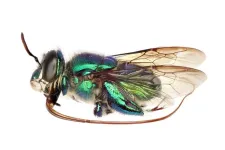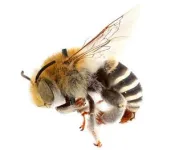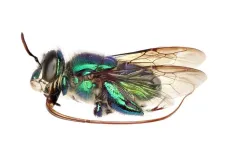(Press-News.org) The first bees evolved on an ancient supercontinent more than 120 million years ago, diversifying faster and spreading wider than previously suspected, a new study shows.
Led by Washington State University researchers, the study provides a new best estimate for when and where bees first evolved. Newly published in the journal Current Biology, the project reconstructed the evolutionary history of bees, estimated their antiquity, and identified their likely geographical expansion around the world.
The results indicate their point of origin was in western Gondwana, an ancient supercontinent that at that time included today's continents of Africa and South America.
“There’s been a longstanding puzzle about the spatial origin of bees,” said Silas Bossert, assistant professor with WSU’s Department of Entomology, who co-led the project with Eduardo Almeida, associate professor at the University of São Paulo, Brazil.
Working with a global team, Bossert and Almeida’s team sequenced and compared genes from more than 200 bee species. They compared them with traits from 185 different bee fossils, as well as extinct species, developing an evolutionary history and genealogical models for historical bee distribution. In what may be the broadest genomic study of bees to date, they analyzed hundreds to thousands of genes at a time to make sure that the relationships they inferred were correct.
"This is the first time we have broad genome-scale data for all seven bee families,” said co-author Elizabeth Murray, a WSU assistant professor of entomology.
Previous research established that the first bees likely evolved from wasps, transitioning from predators to collectors of nectar and pollen. This study shows they arose in arid regions of western Gondwana during the early Cretaceous period.
"For the first time, we have statistical evidence that bees originated on Gondwana," Bossert said. "We now know that bees are originally southern hemisphere insects."
The researchers found evidence that as the new continents formed, bees moved north, diversifying and spreading in a parallel partnership with angiosperms, the flowering plants. Later, they colonized India and Australia. All major families of bees appeared to split off prior to the dawn of the Tertiary period, 65 million years ago—the era when dinosaurs became extinct.
The tropical regions of the western hemisphere have an exceptionally rich flora, and that diversity may be due to their longtime association with bees, authors noted. One quarter of all flowering plants belong to the large and diverse rose family, which make up a significant share of the tropical and temperate host plants for bees.
Bossert’s team plans to continue their efforts, sequencing and studying the genetics and history of more species of bees. Their findings are a useful first step in revealing how bees and flowering plants evolved together. Understanding how bees spread and filled their modern ecological niches could also help keep pollinator populations healthy.
“People are paying more attention to the conservation of bees and are trying to keep these species alive where they are,” Murray said. "This work opens the way for more studies on the historical and ecological stage.”
Additional contributors included Felipe Freitas, Washington State University; Bryan Danforth, Cornell University; Charles Davis, Harvard University; Bonnie Blaimer, Tamara Spasojevic, and Seán Brady, Smithsonian Institution; Patrícia Ströher and Marcio Pie, Federal University of Paraná, Brazil; Michael Orr, State Museum of Natural History, Stuttgart; Laurence Packer, York University; Michael Kuhlmann, University of Kiel; and Michael G. Branstetter, U.S. Department of Agriculture.
View the article in Current Biology.
END
Bees evolved from ancient supercontinent, diversified faster than suspected
2023-07-31
ELSE PRESS RELEASES FROM THIS DATE:
New algorithm ensnares its first ‘potentially hazardous’ asteroid
2023-07-31
Link to Google Drive folder containing images, videos and caption/credit information:
https://drive.google.com/drive/folders/19LP7UZbVKkTXSFds6DaKSy1lp014Hw4z?usp=sharing
Link to release:
https://www.washington.edu/news/2023/07/31/heliolinc3d/
FROM: James Urton
University of Washington
+1 206-543-2580
jurton@uw.edu
Ranpal Gill
Vera C. Rubin Observatory
+1 520-309-6195
rgill@lsst.org
Note: Researcher contact information at the end
For ...
Fascination of Science: 60 Encounters with Pioneering Researchers of Our Time
2023-07-31
What makes a brilliant scientist? Who are the people behind the greatest discoveries of our time? Connecting art and science, photographer Herlinde Koelbl seeks the answers in this English translation of the German book Fascination of Science, an indelible collection of portraits of and interviews with sixty pioneering scientists of the twenty-first century. Koelbl's approach is intimate and accessible, and her highly personal interviews with her subjects reveal the forces (as well as the personal quirks) that motivate the scientists' work; for example, one wakes up at 3 am because ...
Team identifies key driver of cancer cell death pathway that activates immune cells
2023-07-31
CHAMPAIGN, Ill. — Scientists have identified a protein that plays a pivotal role in the action of several emerging cancer therapies. The researchers say the discovery will likely aid efforts to fine-tune the use of immunotherapies against several challenging cancers. They report their findings in the journal Cancer Research.
“Most anticancer drugs cause cancer cells to shrivel up and die in a controlled process known as apoptosis. But apoptosis does not usually strongly activate immune cells,” said David Shapiro, a professor ...
Scrambler therapy may offer lasting relief for chronic pain, review paper suggests
2023-07-31
FOR IMMEDIATE RELEASE
A new review paper co-authored by two Johns Hopkins pain experts suggests that scrambler therapy, a noninvasive pain treatment, can yield significant relief for approximately 80%–90% of patients with chronic pain, and it may be more effective than another noninvasive therapy: transcutaneous electrical nerve stimulation (TENS). The write-up was published online July 13 in The New England Journal of Medicine.
Scrambler therapy, approved by the U.S. Food and Drug Administration in 2009, administers electrical stimulation through the skin via electrodes placed in areas of the body above and below where chronic pain is felt. The goal is to capture the nerve endings ...
Icahn School of Medicine at Mount Sinai receives $11.5 million grant renewal to study the impact of psychosocial stress on cardiovascular disease
2023-07-31
New York, NY (July 31, 2023)—Psychosocial stress profoundly affects people’s lives globally, not least because it can be a critical risk factor for cardiovascular disease. Thanks to an $11.5 million award renewal from the National Heart, Lung, and Blood Institute (NHLBI) of the National Institutes of Health, distinguished researchers at the Icahn School of Medicine at Mount Sinai and elsewhere aim to gain a deeper understanding of how stress influences cardiovascular health.
“To address residual cardiovascular risk in patients, our research program aims to bolster our mechanistic understanding ...
Way cool: UVA professor developing ‘freeze ray’ technology for the Air Force
2023-07-31
You know that freeze-ray gun that “Batman” villain Mr. Freeze uses to “ice” his enemies? A University of Virginia professor thinks he may have figured out how to make one in real life.
The discovery – which, unexpectedly, relies on heat-generating plasma – is not meant for weaponry, however. Mechanical and aerospace engineering professor Patrick Hopkins wants to create on-demand surface cooling for electronics inside spacecraft and high-altitude jets.
“That’s the primary problem right now,” Hopkins said. “A lot of electronics on board heat up, but they have no way to cool down.”
The U.S. Air Force likes the prospect of a freeze ...
Bees likely evolved from ancient supercontinent, earlier than suspected
2023-07-31
PULLMAN, Wash. –The origin of bees is tens of millions of years older than most previous estimates, a new study shows.
A team led by Washington State University researchers traced the bee genealogy back more than 120 million years to an ancient supercontinent, Gondwana, which included today’s continents of Africa and South America.
In a study that proposes a new evolutionary history of bees, the researchers found evidence that bees originated earlier, diversified faster and spread wider than many scientists previously suspected. They published their findings in the journal Current ...
Routinely drinking alcohol may raise blood pressure even in adults without hypertension
2023-07-31
Research Highlights:
An analysis of data from seven studies involving more than 19,000 adults in the United States, Korea and Japan found a clear association between increases in systolic (top-number) blood pressure and the number of alcoholic beverages consumed daily.
Even people who drank one alcoholic beverage per day showed a link to higher blood pressure when compared to non-drinkers, reinforcing the American Heart Association’s advice to limit alcohol intake and to not start drinking alcohol if you do not already.
Embargoed until ...
This disease can be caused by a food allergy and prevent children from eating. A new study may show how to treat it
2023-07-31
A new study from Tulane University has identified a new treatment for a chronic immune system disease that can prevent children from eating.
Eosinophilic esophagitis (EoE) is triggered by food allergies or airborne allergens which causes a type of white blood cell, eosinophils, to build up in the lining of the esophagus. This causes the esophagus to shorten and the esophageal wall to thicken, making swallowing difficult and causing food to get stuck in the throat.
The disease occurs in an estimated 1 in 2,000 adults but more frequently affects children (1 in 1,500) where symptoms can be harder to diagnose and pose greater risks as difficulty feeding can lead to malnutrition, weight loss and ...
Oxycodone prescriptions after delivery not linked to longer-term opioid use compared to codeine prescriptions
2023-07-31
Postpartum prescriptions for oxycodone were not associated with increased risk of longer-term opioid use compared to codeine prescriptions, according to new research published in CMAJ (Canadian Medical Association Journal) https://www.cmaj.ca/lookup/doi/10.1503/cmaj.221351.
Over the last 10 years, there has been a shift to fewer codeine prescriptions and an increase in prescriptions for stronger opioids, such as hydrocodone, hydromorphone and oxycodone for patients postpartum.
“This occurred in part ...








